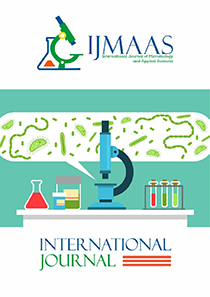Prevalence and Antibiogram of Salmonella enterica Isolated from Seafood Sold in Rivers State, Nigeria
Vol 2, 2023
KEYWORDS
Markets, Seafoods, whelks, oysters, Salmonella enteric, parboiled, antibiogram, prevalence
Abstract
Consumption of seafood contaminated with Salmonella enterica can lead to life threatening illnesses and its multidrug resistance profile is of public health concerns. This study was conducted to determine the prevalence and antibiogram of Salmonella enterica isolated from seafood sold in Rivers State, Nigeria. A total of 126 raw and parboiled samples of Crassostrea gasar (Oyster) (42), Panaeus monodon (Prawn) (42) and Buccinum undatum (Whelks) (42) were purchased from three (3) Local Government Area markets and subjected to bacteriological and biochemical analyses using standard conventional methods. Antibiotic susceptibility pattern was ascertained using Kirby-Bauer disc diffusion method. Total Salmonella count (TSC) for raw Oyster, Prawn and Whelks in Creek Road market were 3.2±0.7×102CFU/g; 3.2±0.5×102CFU/g and 4.7±0.2×102CFU/g respectively. While counts for parboiled samples were 3.0±0.9×102CFU/g; 1.8±0. x102CFU/g and 3.7±0.3×102CFU/g respectively. The TSC for raw Oyster, Prawn and Whelks in Kaa market were 2.9±0.7×102CFU/g; 2.2±0.9×102CFU/g and 3.6±0.2×102CFU/g and counts of parboiled samples were 2.3±0.4×102CFU/g; 1.4±0.2×102CFU/g and 2.8±0.1×102CFU/g respectively. TSC for raw Oyster, Prawn and Whelks from Bakana market were 2.7±0.7×102CFU/g; 1.6±0.2×102CFU/g and 3.1±0.5×102CFU/g while TSC in parboiled samples were 1.6±0.3×102CFU/g; 1.2±0.1×102CFU/g and 2.4±0.2×102CFU/g, respectively. Generally, there was a significant difference (p≤0.05) in the total Salmonella counts across the various markets from the seafoods. Forty (40) Salmonella enterica were isolated from the 126 seafood samples analyzed and Prawn (40%) had the highest prevalence. Salmonella enterica were resistant to Impenem/Cilastatin (97.5%) Augmentin (95%), Cefotaxime (92.5%) and Nitrofurantoin (90%) and sensitive to Ofloxacin (65%) and 100% of the isolates had MAR indices ≥0.2. The high prevalence and resistance rate observed in this study indicates the potential risk of transmission of S. enterica to humans through consumption of inadequately processed seafood, which can have serious implications for public health. It is essential that more effective control strategies be put in place to reduce the prevalence of S. enterica in seafoods sold in Rivers State.
Current: Vol. 4, Issue 1, 2025

Call for papers
The International Journal of Microbiology and Applied Sciences warmly welcome your valuable articles for publication.
